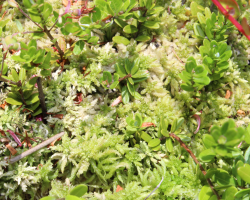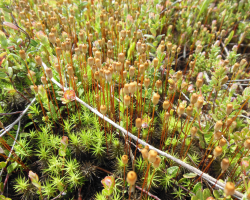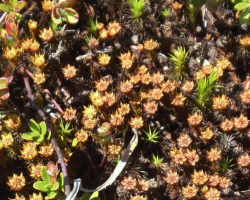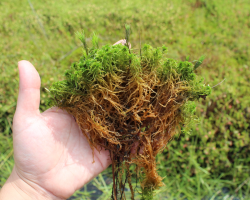Moss: Biology, Diversity, and Yield Impacts on Cranberry (2019)
Mosses are some of the oldest and simplest plants on the planet. They are non-vascular plants, and do not have reproductive structures like flowers and seeds or sophisticated vascular tissues. Moss has been present on cultivated Massachusetts cranberry bogs for decades but was not historically regarded as a high-impact weed. In the last few years, an increasing number of growers have reported moss as a problematic weed in their bogs (Ghantous and
Sandler, 2017). It is unclear why moss has emerged as a major weed. Possible contributing factor are changes in farm practices over time (fertility management, drainage and irrigation practices, other cultural practices), effective control of other weeds with herbicides that create opportunities for moss to thrive (mosses do not respond to herbicides currently registered for use in cranberry), or climate change. Moss has also been documented as an increasing problem in lowbush blueberry, a related crop (Percival and Garbary 2012).
 Moss species and prevalence. Recent surveys as well as historical observations indicate that the most prevalent mosses found in Massachusetts cranberry are haircap moss (Polytrichum commune) and sphagnum (Sphagnum spp.). Haircap moss is widespread and found throughout cranberry beds, even in areas where drainage is not considered an issue. Sphagnums are more typically found on bed edges, ditch edges, and production areas that have drainage problems and high soil moisture.
Moss species and prevalence. Recent surveys as well as historical observations indicate that the most prevalent mosses found in Massachusetts cranberry are haircap moss (Polytrichum commune) and sphagnum (Sphagnum spp.). Haircap moss is widespread and found throughout cranberry beds, even in areas where drainage is not considered an issue. Sphagnums are more typically found on bed edges, ditch edges, and production areas that have drainage problems and high soil moisture.
Recent surveys on a single farm (UMass State Bog, East Wareham, MA) indicates that there is high species diversity of mosses on Massachusetts cranberry beds. Moss samples were collected and sent to the UMass Amherst Herbarium for identification. The survey showed at least seven other species of moss in addition to the common haircap and sphagnum. One bed was sampled in June 2017, and a second bed was sampled in 2018. Other moss species were identified: Aulacomnium palustre (ribbed bog moss), Ceratodon purpureus (ceratodon moss), Entodon seductrix (seductive moss), Ditrichum pallidum (pale ditrichum moss), Pohlia nutans (pohlia moss), Atrichum crispum (atrichum moss), and Callicladium haldanianum (callicladium moss). These additional species found during the two State Bog surveys were found only sporadically (low abundance).
Haircap Moss
Polytrichum commune is found in diverse habitats. Simple, upright green stems 5-15 cm tall with narrow pointed leaves (6-10 mm long) can resemble patches of tiny pine tree seedlings. Stems are attached to the soil by rhizoids, which resemble roots. Stems can be interconnected underground creating large clonal patches. Haircap moss can reproduce vegetatively from buds on the rhizomes, or by spores that result from sexual reproduction. During the reproduction phase, male stems are topped with “splash cups” and water disperses the sperm to nearby female stems. After the egg in the tip of the female plant has been fertilized, a sporophyte emerges from the stem as a 5-9 cm upright stalk topped with a capsule that will release spores. The single-celled spores are released when mature and dispersed by the wind. When they land in a habitable location, spores will imbibe water and germinate into new plants (McKnight et al. 2013; Vashishta et al. 1963).
Sphagnum spp.
Sphagnum is a genus with over 300 species found world-wide that are collectively referred to as “peat moss”. These species tend to form dense carpets. Native sphagnums co-occur with wild cranberry plants in natural bogs and fens (Mason et al. 2014). On cultivated cranberry beds, peat mosses are typically found on bed edges, ditch edges, and production areas that have drainage problems and high soil moisture. Adult sphagnums lack the root-like rhizoid structures that haircap moss has, which may explain why they are found in “wet” parts of the bed while haircap can be found throughout productionareas. They have specialized large, non-photosynthetic, clear cells covered with pores called hyaline cells that allow the moss to absorb water and hold it like a sponge (Vashishta et al. 1963).
Spahgnums consist of a main stem with clusters of branches. The stems grow from the apical tips, and lower portion of the stem dies off and decompose below the living tops. In wild bogs, peat can be several feet thick. Asexual reproduction plays a major role in sphagnum propagation (Cronberg 1992). Side shoots can arise from main stems, buds can arise from stems, or detached stems can give rise to new plants. Sphagnum is capable of sexual reproduction that results in the creation of spores that can be dispersed, but it is unclear how frequently sexual reproduction occurs or how far the spores can be dispersed (Cronberg 1992).
Sphagnum palustre (Blunt-leaved Peat moss) and Sphagnum fimbriatum (Fringed Peat moss) were identified in the 2017 and 2018 survey, as well as a possible sample of Sphagnum majus.

Moss can reduce cranberry yield. To assess the impact of P. commune on cranberry production, two beds of ‘Stevens’ were sampled in September 2018. Cranberry tissue and moss tissue were collected from 30 areas on the beds with varying amounts of moss. Cranberry fruit were quantified, and the plant tissue was then separated by species, dried and weighed. The amount/weight of cranberry fruit was significantly lower in areas with more moss, and biomass of cranberry vines was also lower in areas with more moss.
These findings suggest direct competition between P. commune and cranberry (Colquhoun et al., 2019). This work is being repeated in 2019. In addition to competing with cranberry vines for space and resources, mosses can also absorb and hold moisture and may create microclimates that are beneficial for cranberry pathogens. Moss communities have been shown to harbor assemblages of both beneficial and pathogenic organisms in other commercial and natural ecosystems (Lehtonen et al. 2012; Mason et al. 2014).
Potential Management. Improving drainage and water management my help to eradicate sphagnum moss that thrives wet areas, but anecdotal information indicates that these techniques do not help manage haircap moss once an infestation established. Moss species are non-vascular plants and do not respond to the traditional herbicides registered for use in cranberry (i.e., dichlobenil, norflurazon, napropamide, quinclorac, or mesotrione). Historically cranberry growers have used iron sulfate to control small patches of moss. While registered as an herbicide in turf, no iron sulfate products are currently labeled for this use in cranberry.
Recent herbicide screening efforts have identified two promising candidates for moss control in cranberry. The herbicides were tested on haircap moss, but may also control other species. Applications were made when cranberry plants were dormant in the spring. Cranberry and moss were visually evaluated for injury and fruit were collected, counted and weighed to determine the number and weight of sellable cranberry fruit. At the final evaluation, all treatments had significant moss injury compared to the control, but did not differ from each other. No treatment differed from the untreated control for number or weight of sellable fruit, even for the treatments that showed visual symptoms of injury (Ghantous and Sandler, 2019). Both herbicides demonstrated good crop safety, efficacy against moss, and are registered for use in other food crops. The cranberry industry is actively pursuing registration of these products for cranberry use. Contact the UMass Cranberry Station for updates on moss management.
References
Colquhoun, J., T. Besancon, K. Ghantous and H.A. Sandler, 2019. Determining the impact of weeds on cranberry yield and quality. North American Cranberry Research and Extension Workers
conference, Vancouver, BC. August 18-20, 2019.
Cronberg, N. 1992. Reproductive biology of Sphagnum. Lindbergia : a journal of bryology 17:69-82. Ghantous, K.M. and H.A. Sandler, 2019. Moss impacts and control efforts in cranberry. Proceedings of the
Northeastern Plant, Pest, and Soils Conference, 4:57.
Ghantous, K.M. and H.A. Sandler, 2017. Moss as an emerging weed problem in cranberry. North American Cranberry Research and Extension Workers conference, Plymouth, MA. August 28-30, 2017. http://scholarworks.umass.edu/nacrew/2017/papers/19.
Lehtonen, M.T., E.M. Marttinen, M. Akita, and J.P.T. Valkonen. 2012. Fungi infecting cultivated moss can
also cause diseases in crop plants. Annals of Applied Biology 160:298-307.
Mason, C. J., E.L. Zeldin, C.R. Currie, K.F. Raffa, and B.H. McCown. 2014. Populations of uncultivated
American cranberry in sphagnum bog communities harbor novel assemblages of Actinobacteria with antifungal properties. Botany 92:589-595.
McKnight, K.B., J.R. Rohrer, K.M. Ward, and W.J. Perdrizet. 2013. Common Mosses of the Northeast and
Appalachians. Princeton: Princeton University Press 391 p.
Percival, D. and D. Garbary, 2012. Moss competition dynamics and suppression technologies in wild
blueberry production. Internat. J. Fruit Sci. 12(1-3), 135-145. doi:10.1080/15538362.2011.619358.
Vashishta, B.R., A.K. Sinha, and A. Kumar. 1963. Bryophyta (Rev. 2011). New Delhi: S. Chand Publishing
Katherine Ghantous, Hilary Sandler, and William Kerrester, September 2019
UMass Cranberry Station P.O. Box 569, East Wareham, MA 02538


